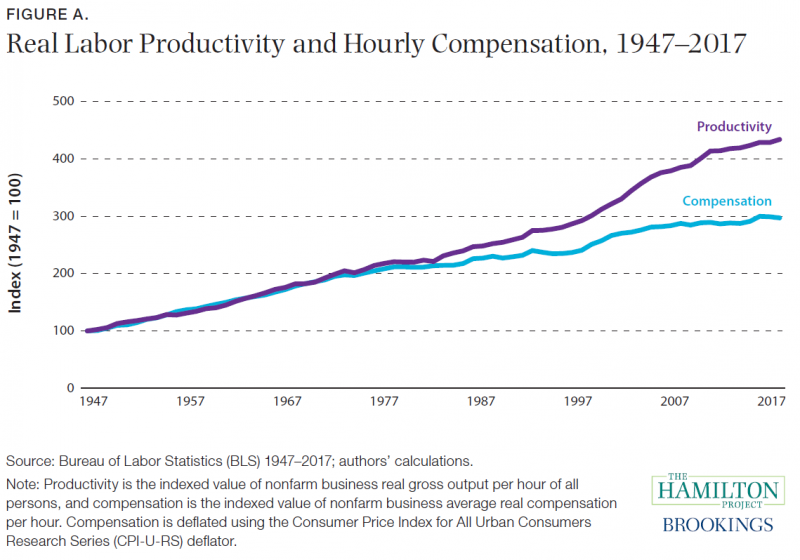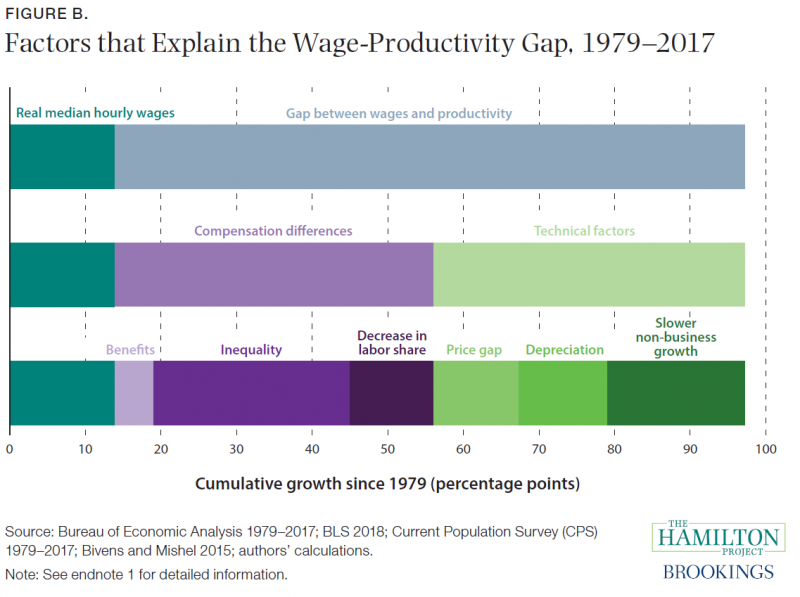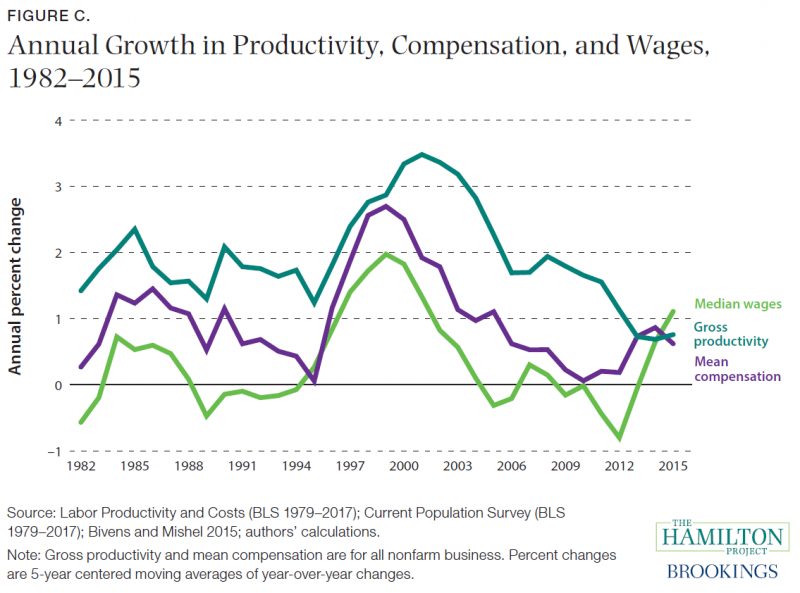Foreword
One simple question—are wages rising?—is as central to the health of our democracy as it is to the health of our economy. Without rising wages, the dreams of American families to live in good homes, to support their families, to retire comfortably, and to see their children do better—what we call the American Dream—simply cannot be realized.
One of the best measures economists use to determine Americans’ ability to achieve this dream is whether wages are rising, broadly and consistently. For the last few decades, and for too many workers, they have not. The U.S. economy has experienced long-term real wage stagnation and a persistent lack of economic progress for many workers. The median worker in 2017, for instance, earned only slightly more than in 1979.
Over the long arc of U.S. history wages have fluctuated along with the economy. Real wages are affected by inflation and by the supply and demand for labor. They can move depending on the progress of technological advances, the strength or weakness of capital investment, the size of workers’ nonwage benefits, or conditions that affect labor’s share of economic output.
What makes the past forty years different from earlier U.S. history are the new and more-stubborn factors contributing to the stagnation of a typical worker’s pay. Wages have risen for those in the top of the distribution, but—with the exception of brief periods like the latter half of the 1990s—they have been stagnant for those in the bottom and middle. Wages have grown for women and fallen for men, while remaining much lower for people of color. Globalization and technological change are exerting downward pressure on the wages of some less-educated workers. Declines in the real minimum wage and union membership have also lowered wage growth.
Wage growth now also varies significantly by location, with wages in poor areas increasingly less likely to catch up to those in rich areas. Households have become less mobile: today’s workers are less likely to move to a different state or to a different job, which intensifies the disparities among regions (Ganong and Shoag 2017). The fact that business start-ups and closings have also declined—a signal of decreased firm dynamism—has in turn likely lowered productivity growth and disrupted wage ladders in ways that have been particularly deleterious for wage growth. Even if incumbent firms increased their innovative activity, removing one concern regarding the decrease in start-ups, the smaller number of new firms reduces job switching opportunities for workers and puts downward pressure on wage growth.
Wage stagnation does more than constrain family budgets: it also leaves workers and families feeling discouraged, even disenfranchised. Working year after year without a meaningful rise in wages weakens workers’ confidence in the economic system. Even more, it undermines their faith in democratic institutions to make the necessary changes in public policy to deliver a robust improvement in their standards of living. As former Treasury Secretary Lawrence Summers, a member of our advisory council, wrote in September 2017, “The central issue in American politics is the economic security of the middle class and their sense of opportunity for their children. As long as a substantial majority of American adults believe that their children will not live as well as they did, our politics will remain bitter and divisive” (Summers 2017). Stagnant wages divide us not only by income, but also by our understanding of what it means to be an American and to have our own shot at the American Dream. For this reason, with so much at stake, the task of restarting wage growth has taken on great urgency.
Hence, the decision to publish this volume. For more than a decade The Hamilton Project has offered proposals and analyses aimed at promoting economic growth, broad-based participation in growth, and economic security. Here we have assembled the evidence and analysis that detail why wages have been stagnant for so many workers, and identified public policies that could effectively contribute to the growth in productivity and wages that are core parts of improving living standards for all Americans.
Slow productivity growth and stagnant wages are complex puzzles, but are not insoluble. In the following chapters, our experts offer evidence-based policy proposals to support wage growth through increased productivity. These proposals include greater support for policies that increase human capital (education and training policies), boost worker mobility, and sustain robust labor demand.
Other experts featured in this volume propose raising wage growth by strengthening worker bargaining power. Enhanced wage transparency, modernized labor market standards and institutions, and more-competitive labor markets can all play important roles in helping workers share in the benefits of economic growth. When these policies help match workers to more productive jobs, they can raise economic growth as well.
The goal shared by each proposal is raising productivity growth and wages as engines for creating a faster-growing and more-dynamic economy that will benefit all workers over the long term. We offer the proposals with the conviction that forty years of stagnation need not presage forty more. If we are able to put in place a policy regime to reverse these long-term trends, we can restore Americans’ confidence in the economy and in the American Dream.
Introduction
by Jay Shambaugh, Ryan Nunn, and Becca Portman
Growth in real median hourly wages of American workers has been minimal since 1979. This stagnation continues to have stark implications for the U.S. economy. It has adversely impacted both the living standards of individual Americans as well as the country’s overall macroeconomic growth.

Wages are only one component of compensation, which also includes nonwage compensation such as group insurance (e.g. health, dental, and life), disability income protection, and retirement benefits. Accordingly, when these other components of compensation are taken into account, wages have grown slightly more slowly than compensation. The divergence between median and average wages—a measure of income inequality—also helps determine how well typical workers fare. As inequality has grown, median compensation has lagged productivity by even more than average compensation.
Figure B describes the various components of the gap between cumulative wage and productivity growth. Real median wages increased by only 14 percent from 1979 to 2017, while gross productivity increased by more than 97 percent, leaving a gap of over 83 percentage points. Some of this gap can be explained by shifts in how productivity gains are split up as compensation, either through increases in nonwage benefits, gaps between average and median pay, or shifts from workers to firms. However, benefits, or the difference between median compensation and median wages, explain only 5 percentage points of the difference between wages and productivity.

A much larger portion of the gap is due to inequality, or the difference between median and average compensation, which explains 26 percentage points of the gap. More and more productivity gains have gone to the top of the income distribution, leading median compensation growth to fall short of productivity growth, while average compensation growth has come closer. In addition, roughly 11 percentage points of the gap can be attributed to a decline in the labor share of income as total compensation to labor has fallen and the share going to capital has increased.
A number of technical factors also explain the divergence between nonfarm business sector productivity and median wage growth. Prices for U.S.–produced output (used in the calculation of productivity) have grown more slowly than consumer prices (used to calculate real wages). Thus, some of the slower growth in real wages stems from the fact that the prices used to calculate inflation-adjusted wages are growing more quickly than those used to calculate inflation-adjusted output.
In addition, depreciation—which in theory should be subtracted from the productivity growth that is available for compensation growth—now makes up a larger share of output. Finally, productivity in the overall economy—including government, the nonprofit sector, and the farm sector—has grown more slowly than productivity in the nonfarm business sector, which is typically the focus of productivity growth measurement. One would expect wages for workers overall to track total economy productivity, rather than nonfarm business productivity. While these technical factors explain some of the gap in figure A, the dual features of rising inequality and declining labor share explain a sizable amount.
For a typical American worker to get a larger raise, continued productivity growth is just the first prerequisite. In addition, the gains from productivity cannot go only to firms (decreasing labor share) or to high-income workers (increasing inequality).
Understanding the long-run divergence between productivity and wages is essential to understanding wage stagnation. Just as important, however, are labor productivity growth and the factors that have limited it in recent years. Beginning after the 1995-2004 technology boom-and worsening during the recovery from the Great Recession-productivity growth has been unexpectedly weak (Fernald 2015). Given the importance of labor productivity growth for facilitating wage growth, this slowdown in productivity growth has likely had negative effect on workers (Stansbury and Summers 2017). Figure C demonstrates the interrelatedness of productivity and compensation growth, both of which have fallen in recent years.

Although gross productivity, mean compensation, and median wages do rise and fall together—indicating the importance of productivity growth—wages and compensation have failed to keep up with productivity over the last few decades. In the past five years, however, growth in median wages and mean compensation began to converge with the productivity growth rate. If this trend were to continue, the shift in the labor share would begin to reverse.
In order to effectively address the problem of slow wage growth, two types of policy intervention are required: (1) reforms that increase productivity growth and (2) reforms to ensure that typical workers receive a larger share of that growth. Both investments in human capital and efforts to increase economic dynamism (e.g., the pace of new business formation and job switching), among other possibilities, can lead to enhanced productivity growth. Section I of this book explains the effect of diminished dynamism on wage growth and evaluates efforts to raise wages and productivity through human capital investments.
Section II contains three specific policy proposals that, if implemented, will contribute to wage growth through stronger productivity growth. Fatih Guvenen of the University of Minnesota proposes a set of reforms, including additional investments in education, to enhance the median worker’s lifetime income. Abigail Wozniak of the University of Notre Dame proposes reforms to the student financial aid system that would encourage both the pursuit of a college degree and geographic mobility, both of which contribute to economic dynamism. Finally, Jared Bernstein of the Center on Budget and Policy Priorities offers proposals that would boost labor demand and help more people find well-paying work.
Finally, Section III offers policy proposals to enhance workers’ share of economic activity by strengthening their bargaining power, while mitigating income inequality. Matt Marx of Boston University proposes reforms to non-compete agreements, which firms often abuse to limit worker mobility and career progress. Alan Krueger of Princeton University and Eric Posner of the University of Chicago Law School examine the effects of employer collusion on worker opportunities and suggest limitations to collusive practices. Benjamin Harris of the Kellogg School of Management outlines proposals to enhance wage transparency, reducing workers’ disadvantage in wage negotiations, and Heidi Shierholz of the Economic Policy Institute recommends a suite of labor market policy reforms that would benefit low- and middle-wage workers.
Although productivity and worker bargaining power are useful categories for separating the proposals included in this book, they are closely interrelated, and many of the outlined policies address both productivity and labor share simultaneously. For example, helping workers switch jobs more easily should relocate them to better firms and lift productivity growth while also improving workers’ bargaining power and raising labor’s share of income. Similarly, keeping the economy near full employment with strong labor demand could contribute to productivity growth as well as worker bargaining power. Ultimately, revitalizing wage growth will require a multifaceted approach that fuels long-term, broad-based growth for all Americans.
Section I: Understanding Wage Stagnation and Its Policy Solutions
Chapter 1: How Declining Dynamism Affects Wages
by Jay Shambaugh, Ryan Nunn, and Patrick Liu
Abstract:
Wages have stagnated in recent decades for typical workers. While a number of economic, policy, and technological developments bear some responsibility, economists have grown increasingly concerned that declining dynamism is an important cause. The decline in dynamism encompasses the various ways in which workers and entrepreneurs have become less likely to explore new patterns of economic activity: starting new, fast-growing businesses; switching jobs; and moving across the country. As these activities diminish, both productivity growth and worker bargaining power suffer, limiting workers’ opportunities and damaging wage growth. Improving the ability of workers to switch jobs could thus improve both their wages and their productivity. Declining dynamism may suggest a role for public policy in establishing the conditions for workers to successfully climb the job ladder.
Chapter 2: Returning to Education: The Hamilton Project on Human Capital and Wages
by Jay Shambaugh, Lauren Bauer, and Audrey Breitwieser
Abstract:
Human capital is central to raising wages. This framing paper describes trends in human capital investment and educational attainment, and reviews the evidence of wage returns to educational attainment and to early childhood education, K-12 education, postseconday education, and workforce development policies and programs. Finally, this paper synthesizes a decade of Hamilton Project policy proposals on education and human capital around a framework of access, affordability, and quality.
Section II: Policies to Boost Wages through Enhanced Productivity
Chapter 3: Stagnation in Lifetime Incomes: An Overview of Trends and Potential Causes
by Fatih Guvenen
Abstract:
Lifetime incomes have stagnated for the majority of American men since the cohort of workers that entered the labor market in the late 1960s. The evidence shows that those who turned age 25 after the 1960s have experienced a large decline in their starting wages relative to earlier cohorts, and did not experience faster growth in their wages over the life cycle to make up for those earlier losses, resulting in lower lifetime incomes. These trends coincided with a stagnation of educational attainment for men, as well as rising income disparities among workers with some college experience. In light of these facts, this paper presents some design considerations for human capital policies that aim to boost wage growth for younger workers by: (1) identifying promising labor market data collection practices to ensure that students are taught skills that are both valued in their local labor market and resilient to shifts in demand, and (2) providing targeted tuition subsidies for enrollment in two-year community colleges and technical colleges.
Chapter 4: Coming and Going: Encouraging Geographic Mobility at College Entry and Exit to Lift Wages
by Abigail Wozniak
Abstract:
Geography is an important part of economic opportunity—but due to monetary and nonmonetary costs of migration, college attendance is less likely for those who live farther from postsecondary institutions. The college educated have also become increasingly concentrated in larger labor markets, while at the same time mobility across markets is falling. Abbie Wozniak proposes two modifications to the existing Federal Student Aid programs to level the playing field on these dimensions. At college entry, she proposes creating large supplements to the Federal Pell Grant Program to help students who do not have access to a local college overcome the high implied costs of relocating for college. She then proposes that college leavers receive extended automatic deferments to Federal Student Loan (FSL) repayment when relocating across markets to start their careers.
Chapter 5: The Importance of Strong Labor Demand
by Jared Bernstein
Abstract: By conventional measures, the U.S. job market has suffered some degree of slack for about 70 percent of the time since 1980. The absence of persistent, strong labor market demand has a significant negative impact on wages and incomes, with these costs falling disproportionately on the least advantaged. In this paper, Jared Bernstein offers a four-part proposal to increase labor demand along with earnings and employment opportunities: (1) reform our monetary policy framework to accommodate more monetary stimulus and reduce the risk of hitting the zero lower bound, (2) develop a Full Employment Fund to reduce labor market slack, (3) support direct job creation programs to boost labor demand, and (4) design international trade policies to safeguard aggregate demand and mitigate the negative effects of trade deficits.
Section III: Policies to Boost Wages through Strengthened Worker Bargaining Power
Chapter 6: Reforming Non-Competes to Support Workers
by Matt Marx
Abstract: This report describes evidence from empirical research on non-compete agreements and recommends policies to balance the interests of firms and workers. Firms use non-competes widely in order to minimize recruiting costs, safeguard investments, and protect intellectual property more easily than is achieved via non-disclosure agreements. But these benefits come at a cost to workers, whose career flexibility is compromised—often without their informed consent.
Chapter 7: A Proposal for Protecting Low-Income Workers from Monopsony and Collusion
by Alan Krueger and Eric Posner
Abstract: New evidence that labor markets are being rendered uncompetitive by large employers suggests that the time has come to strengthen legal protections for workers. Labor market collusion or monopsonization—the exercise of employer market power in labor markets—may contribute to wage stagnation, rising inequality, and declining productivity in the American economy, trends which have hit low-income workers especially hard. To address these problems, Alan Krueger and Eric Posner propose three reforms. First, the federal government should enhance scrutiny of mergers for adverse labor market effects. Second, state governments should ban non-compete covenants that bind low-wage workers. Third, no-poaching arrangements among establishments that belong to a single franchise company should be prohibited.
Chapter 8: Information is Power: Fostering Labor Market Competition through Transparent Wages
by Benjamin Harris
Abstract: Lack of competition in the labor market is gaining attention as a source of wage stagnation in the United States. One component of this challenge is asymmetric information on wages, whereby employers have superior knowledge of the distribution of wages relative to workers. This asymmetry of information is potentially suppressing wage growth as it limits workers’ ability and inclination to negotiate for higher pay. This paper advances a five-part proposal to improve wage transparency as a strategy for improving worker bargaining power, and ultimately, raising wages across the income distribution.
Chapter 9: Strengthening Labor Market Standards and Institutions to Promote Wage Growth
by Heidi Shierholz
Abstract: For most of the period since the 1970s the United States has suffered from two trends: stagnant wages for most workers and rising inequality. In this paper, Heidi Shierholz focuses on the erosion of labor standards, institutions, and norms that has reduced the bargaining power of low- and moderate-wage workers. She proposes a suite of remedies to help strengthen worker bargaining power and increase wages, including increasing the minimum wage and the overtime salary threshold, passing fair scheduling laws, boosting unionization, passing paycheck transparency laws, restricting employer tactics to keep wages low and reduce worker leverage, ensuring immigrant workers have full labor rights, and boosting both enforcement of and compliance with labor regulations.


